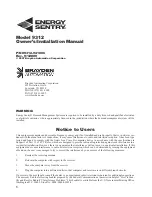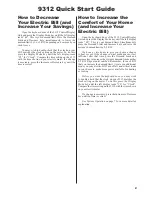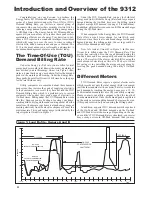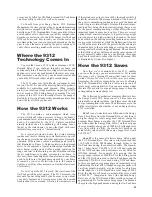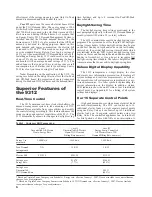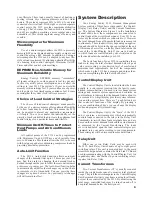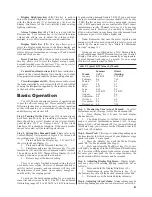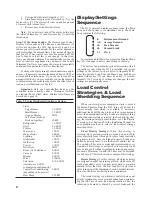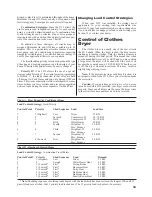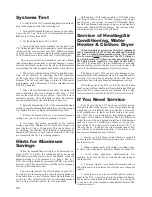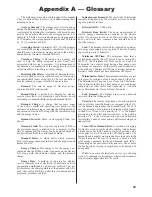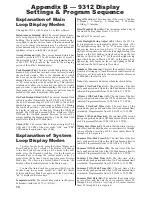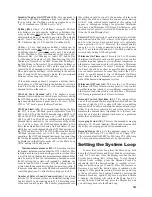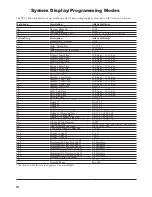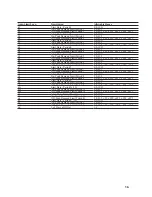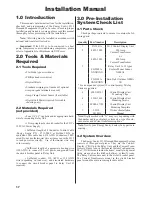
4
or may not be billed for Off-Peak demand. On-Peak times
vary from utility to utility; as well as, by season.
To benefi t from your Energy Sentry 9312 Demand
Management System you must have a demand measuring
electric meter equipped with the TOU/Demand option and
be billed on a TOU Demand Rate from your utility. Obtain
a rate booklet or rate sheet from your utility company that
describes your electric rate, the KW charges, On-Peak and
Off-Peak hours, and how to read your electric meter. We
recommend that you read your metered demand on the day
prior to when the meter is read by the power company, to
verify that your setting matches the meter’s reading.
Where the 9312
Technology Comes In
You wouldn’t need a 9312 to take advantage of TOU
Demand Rates if you could go through your home and
continuously turn off heating or cooling circuits and major
appliances to level out peak demand whenever necessary.
But remember, one slip in any one demand interval and
your utility bill would refl ect a high demand charge.
The 9312 takes over this diffi cult, continuous burden
for you. The 9312 is one of the most sophisticated products
available for controlling peak demand. When properly
used, it can result in average monthly savings of up to 35%
and as much as 50% during heavy-use months. The sole
purpose of the 9312 is to effi ciently allocate the usage of
electricity to electrical loads so that demand peaks are kept
below the level which you have set.
How the 9312 Works
The 9312 contains a microcomputer which turns
certain circuits off when necessary to keep your home’s
peak demand below a limit that you preset. Not all circuits
need to be controlled by the 9312. Circuits controlled
usually include the air conditioning, all heating zones,
the dryer, the water heater, or any other load with some
thermal storage capacity or “thermal inertia”.
In a typical all-electric home, the winter morning
routine may involve turning up some thermostats, operat-
ing the range, water heater and other appliances. Normally,
operation of these loads causes a morning peak (such as
that illustrated in Figure 1) which registers on the demand
meter. In the summer, a typical routine might include the
water heater cycling on and off as needed, operating the
range and later in the morning or early afternoon running
the air conditioner or cooling systems in your home. In
this case, these loads might cause an afternoon or evening
peak. In both cases, the peak demand used by your home
is caused by your use of electricity due to the season or
weather; as well as other normal non-weather related uses
of electricity.
Now, let’s put the 9312 to work. The start time of the
On-Peak period has just passed. The 9312 measures the
amount of power being used by the home as you go about
your daily business and it recognizes when the demand
limit is about to be exceeded. It waits a few minutes to see
if these loads are going to turn off by themselves while it
carefully calculates the average demand of the home. If
the power consumption continues to exceed the demand
limit, it begins to turn off loads. It turns off the least impor-
tant load fi rst, using the load control strategy that you set.
As the power consumption drops, it then allows the most
important loads to come back on fi rst. There are several
optional load control strategies. A typical strategy might
provide power to a higher priority load such as the dryer
and cut back on the heating or cooling loads in one or more
rooms, or the water heater while the higher priority load is
on. When the dryer turns off, the power it had been using is
channeled back to the room heating or cooling, thus main-
taining comfort but reducing peak demand. The end result
is that while you have still used about the same amount of
energy normally called upon by your lifestyle, this usage
has been leveled out to reduce the On-Peak demand. This
is illustrated by Owner B in Figure 1.
How the 9312 Saves
Now that we’ve examined how the 9312 enables
you to use the energy you are accustomed to, but spreads
this usage out by turning off non-critical loads for short
periods of time, let’s look at how this saves you money.
Remember, the utility company helps you save by offering
the TOU Demand Rate which is a lower rate per unit of
total energy consumed (Kwh). You can save money under
this rate if you control your peak energy usage to keep the
corresponding demand charge low.
The following hypothetical examples illustrate how
the Energy Sentry 9312 helps you save. Three cases are
presented for a single residence. In all three cases the total
energy consumption is the same. The differences are in the
utility rate structure and whether or not an Energy Sentry
9312 is installed.
Case I
is an all-electric home billed under the Energy
Rate. This differs from the Demand Rate, in that there is
a higher charge for total energy used and no charge for
demand. Most homes not under the TOU Demand Rate
are billed under the Energy Rate. Table 1 on the next page
shows a monthly energy use of 3000 Kwh. Although rates
vary from utility to utility, the electric bill based on an
actual utility rate sheet for this energy usage level would
be $218.28.*
Case II
is the same all-electric home billed under
the TOU Demand Rate. This rate is structured such that
11:00 AM to 10:00 PM Monday through Friday is the
On-Peak time during the summer schedule. The remain-
ing 13 hours from 10:00 PM to 11:00 AM and weekends
are the Off-Peak time when customers are not billed for
Off-Peak demand. For example, let’s assume that the
energy usage remains at 3000 Kwh for the billing period
and that 750 Kwh were used in the On-Peak times and the
remaining 2250 Kwh were used during Off-Peak times.
In this case, peak energy usage plays an important part in
determining the total bill. Although energy use peaks will
vary from month-to-month, a typical value for a high-use
month might be 19 KW. Based on a total usage of 3000
Kwh, the electric bill based on actual utility rates would
be $201.54**. Compared to Case I (the standard Energy
Rate), use of the TOU Demand Rate results in savings of
approximately 8% for the same energy usage. The demand
charge for the high peak demand during the On-Peak time



